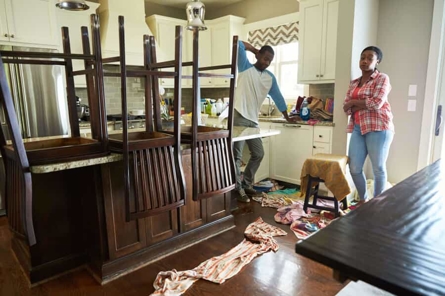Rehabilitation and reconstruction operations are integral parts of recovering your home after a natural disaster. Oklahomans know this intimately as we live through tornado season each year. Living through a tornado or flood can be devastating, and the aftermath can be overwhelming. When considering rehabilitation vs. reconstruction and which option might be best for your situation.
You are not alone when a natural disaster occurs. ServiceMaster Restoration by RSI is here to help you through the recovery, which involves understanding your options and the steps needed to get you back into your home.
Steps to Take Following a Natural Disaster
- Check-in. Let your family and friends know you are safe. Phone lines are commonly down or busy after a natural disaster. Consider checking in on your social media channels or using text messaging.
- Register with FEMA. Recovery aids rush supplies and services to affected areas after a disaster. The Federal Emergency Management Agency (FEMA) coordinates these efforts. Register with FEMA as soon as possible following a disaster, even if you have insurance.
You may be able to get money back from the IRS or other government entities if you have damaged or lost property in a federally-declared disaster area. There is no charge to register or to maintain your registration.
- Find Shelter. See if you can stay with family or friends nearby who weren’t affected by the disaster. If not, groups such as the American Red Cross commonly stage shelters in schools, convention centers, churches, or other large venues following disasters. The Red Cross also provides food, clean-up supplies, and other support services.
- File an Insurance Claim. Contact your insurance company to understand your coverage. Some insurance companies set up temporary offices or have on-site catastrophe response teams during disasters. These efforts allow them to provide quicker services when a disaster impacts a community. Keep a record of all correspondence with your insurance agent and be there when the adjuster surveys the damage. Your insurance provider should assist in determining what they will cover during the rehabilitation vs. reconstruction phases.
Hot Tip: Document all disaster-related communication, damage, and services via a list and photos. Be sure to save all your receipts.
- Contact Your Mortgage Provider. Check-in with your bank or lender to understand your mortgage requirements. The disaster may impact the conditions of your loan.
- Get Help. If your home has experienced significant damage, you need to start the rehabilitation vs. reconstruction process. Understanding the different approaches will help set expectations.
- Beware of Scams. Scammers are unfortunately common after a natural disaster. They look to take advantage of people desperate for help. Hire only licensed, bonded, and insured contractors to work on your home.

Rehabilitation vs. Reconstruction — What’s the Difference?
Rehabilitation after a natural disaster is a systematic return to your pre-disaster status. It is the actions taken in the aftermath of a disaster to enable the structure to function. This step is often considered the transitional phase between immediate relief and long-term rebuilding.
Rehabilitation may not restore the damaged structures in their previous form or location. It may include the replacement of temporary arrangements established as part of emergency response.
Reconstruction is the long-term development of your home that allows you to live there again. It is the permanent construction or replacement of severely damaged structures. It is full restoration. When reconstruction is complete, your home or other property should look and function just as it did before the disaster.
What is a Renovation?
Renovation is the process of renewing a building or structure by fixing what is already present. It also could include adding new components. Typically, contractors complete renovations in conjunction with reconstruction.
For example, if a tornado damaged your home’s kitchen. You want to reconstruct the room, but you also may want to update the space. Modernizing the kitchen is renovating the space during reconstruction.
Rehabilitation vs. Reconstruction After Disasters
Recovering from a disaster can include everything from drying the floors and walls to completely rebuilding the structure. The nature of services largely depends on the intensity of damage caused by a disaster.
SMRSI provides a full array of post-disaster services. We can assess the need for rehabilitation vs. reconstruction and help you understand each step of the process.
Some of the essential services you may need immediately following a natural disaster are:
- Emergency Power. It is common during a disaster to experience power outages that last several days, even weeks. A generator for power could be necessary. SMRI can ensure contractors professionally install the generator, and it’s running correctly.
- Board-up. If possible, boarding your home before the storm can help protect the structure from flying debris. Exposed windows can leave your home open to further storm damage. Boarding also can protect your home from vandals and thieves after the storm.
- Building Stabilization. You want to ensure your home’s stabilization before you begin any work. Stabilization will ensure safe working conditions and prevent additional damage.
- Evaporation. Dehumidification and water extraction services are needed if your property sustains water damage. Quick removal can prevent mold growth.
- Sublimation. Also called freeze-drying, sublimation occurs when, under the proper temperature and pressure, ice passes directly to the vapor state, bypassing the wet form. Sublimation offers good overall results and has several advantages because it removes water instantly in a solid ice state.
Evaporation and sublimation are two different components of drying styles and each might be used in different situations.
How SMRSI Can Help
Living through a natural disaster is stressful. SMRSI wants to help eliminate the stress and uncertainty in getting you back into your home. Our response team is available for contact 24/7 to guide you through the process and provide the expertise needed to quickly and safely get you back in your home.


